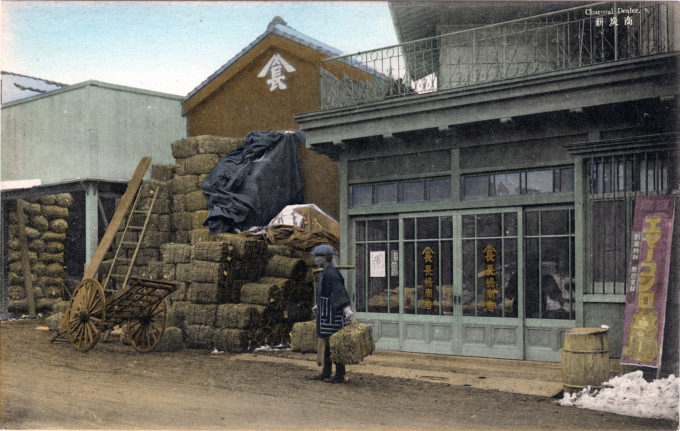“Charcoal is one of the chief forest products of the county, and Matsunagi shares in this regional industry on a modest scale . There are currently only four part-time charcoal burners in the buraku (community), but during the war as many as nine producers were active.
“Their packed-earth kilns, which are located in the very tracts from which the charcoal wood is cut, are constructed by the operator’s household with occasional assistance of hired labor. A kiln is elliptical, built on a rough log frame and varying in size according to the area of forest to be burned.
“Most charcoal is made of pine or cork oak, and, as in lumbering, only the wood in the tract to be burned is purchased by the operator, the price being based on the quality of the trees and the probable volume of wood.
“Rarely do charcoal burners of Matsunagi operate far from home, for during the five days or so that the wood burns, the operator must be able to come and go at any hour.
“Finished charcoal is packed in containers of pampas grass (Miscanthus sinensis) which are made in the household, mostly by old men. There is a cooperative association of charcoal burners in the mura (village), but it has little function except to inspect the finished charcoal in order to maintain its quality. The charcoal burner, alone or with the help of neighbors or relatives, leases woodland and disposes of his goods to dealers in nearby towns.
“The market for charcoal is seasonal, but burners in Matsunagi continue to operate their kilns through the summer, storing the product until colder weather. Although charcoal burning does not require high capitalization, it is costly in time and demands considerable experience and skill. It is, however. one trade that a man with no technical training and little property can attempt with the prospect of earning a modest livelihood.”
– Two Japanese Villages, by John Bilheimer Cornell, 1956

“Charcoal dealer”, Nagashima shoten, Japan, c. 1920. Bundling the charcoal in straw makes for easy transport and storage.
See also:
Tobacco Pipe-selling & cleaning vendor (yatai), c. 1910.
Amezaiku [sugar sculpture] street vendor, c. 1930.
“The utilitarian purposes to which the cherry-tree may be put are [many and] not confined to these.
“The wood is highly valued as material for engraving in block-printing. Thus it has a part to play in the sphere of culture. The bark, glossy brownish black in colour, is used in manufacturing, especially for decorative veneering.
“The wood, too, makes excellent charcoal, and sakura-sumi (cherry charcoal) of commerce is something that adds comfort and beauty to home life in the cold season.
“As a blue-stocking of old has pointed out in her record of miscellaneous impressions and sentiments of life that centred itself round the Court in ancient Japan, a hibachi (brazier) with charcoal, cherry charcoal for preference, red with heat and softened with a thin coating of snow-white ashes, forms a feature that is comparable in effect with any other piece of furniture in making a parlour artistic to a man of taste.”
– “Sakura”, The Tourist, March 1920

